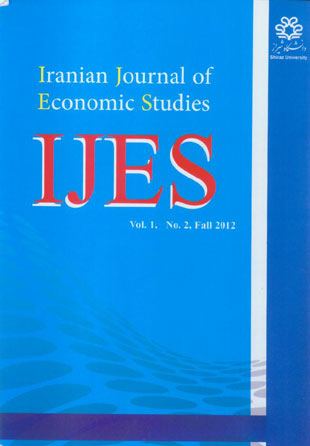فهرست مطالب

Iranian Journal of Economic Studies
Volume:1 Issue: 2, Autumnl 2012
- تاریخ انتشار: 1391/11/25
- تعداد عناوین: 6
-
-
Pages 1-22In a managed floating exchange rate regime, one of the most important issues is the degree to which the monetary authorities intervene in the foreign exchange market. The appropriate level of intervention in the foreign exchange market can be discussed in a framework which emphasizes the trade-off between changes in the country’s level of international reserves and minimizes the country’s real exchange rate misalignment. In this paper we derived an optimal intervention rule for the period of post managed floating regime in Iran applying a dynamic programming approach. The derived rule indicates that, in the context of the Iranian economy, how the monetary authorities can manage the foreign exchange market with minimum possible cost.Keywords: Foreign exchange market intervention, Foreign reserves management, Optimal rule, Dynamic programming
-
Pages 23-47There are several researches that deal with the behavior of SEs and their relationships with different economical factors. These range from papers dealing with this subject through econometrical procedures to statistical methods known as copula. This article considers the impact of oil and gold price on Tehran Stock Exchange market (TSE). Oil and gold are two factors that are essential for the economy of Iran and their price are determined in the global market. The model used in this study is ARIMA-Copula. We used data from January 1998 to January 2011 as training data to find the appropriate model. The cross validation of model is measured by data from January 2011 to June 2011. We conclude that: (i) there is no significant direct relationship between gold price and the TSE index, but the TSE is indirectly influenced by gold price through other factors such as oil; and (ii) the TSE is not independent of the volatility in oil price and Clayton copula can describe such dependence structure between TSE and the oil price. Based on the property of Clayton copula, which has lower tail dependency, as the oil price drops, stock index falls. This means that decrease in oil price has an adverse effect on Iranian economy.Keywords: Stock Exchange market (SE), Oil, Gold, Copula, ARIMA processes
-
Pages 49-67The purpose of this study is to investigate the factors affecting the manufacturing industry wage among selected developing countries based on new economic geography theory. More specifically, we use a panel data model to study the spatial structure of wages in 136 countries for the period 1998-2007. The results indicate that this theory provides a good description of the spatial structure of wages. We find that the market size and the distance-weighted have positive relationships with wage. However, the price of non-tradable goods has a negative effect on the spatial structure of wages. The result shows that the conditions governing the labor market is more important in explaining wage inequalities than the characteristics of labor or labor productivity.Keywords: New Economic Geography, Spatial Structure of Wage, Centralization, Transport Costs, Developing Countries
-
Pages 69-94The main purpose of this paper is to obtain the optimal amount of expenses of government relating to the protection of property rights (PPRs). To achieve these purposes we have introduced concept of social intelligence with respect to PPRs and then developed different growth model from existing literature. In the second step the optimal share of government spending on the PPRs is calculated. The theoretical results show inverse relationship between budget deficits and government spending in the PPRs. In other words, with increasing amount of government deficit, government reduced spending of PPRs. The results of calibration for Iranian economy show that, the growth rate of spending to PPRs should be equal to 31 percent for having sustainable economic growth rate of 6 percent.Keywords: Augmented Endogenous Growth Model, Property Rights, Calibration, Iran
-
Pages 95-106In this study, the social welfare impacts of the interaction of Iranian rice import policies and Thai export policies are analyzed using a game theoretic approach in conjunction with econometric supply and demand models. The joint impacts of increasing the world price of rice, resulting from the export policies in Thailand along with changes in tariff rates in Iran, on social welfare are analyzed in the two countries. Because Iran is a small country in terms of the volume of world rice trade its policies do not influence Thai social welfare. Results of this study show that in order to maximize its own social welfare, the government should impose a modest tariff rate of approximately 3%. This is much less than the actual tariff rate applied in recent years, e.g. 19% in 2007.Keywords: Game Theory, Social Welfare, Tariff Rate, Rice Imports, Iran, Thailand
-
Pages 107-124There is a controversy in economics about the fairness of intergenerational discounting. In other words, the question is whether it is fair to discount the utility of future generation less than that of the present one. Ramsey (1928) was the first economist to criticize the intergenerational discounting. He argued that the just rate of discounting should be zero. Using Islamic perspective, this paper attempts to calculate the just rate of intergenerational discounting for the Iranian economy when allowing oil revenue to be invested in other forms of capital. More specifically, we develop an overlapping generation model to calculate a just rate of social discount from an Islamic point of view. Our results show that the value of social discount rate before imposing the intergenerational justice condition is 0.04 and -0.014 afterwards. Using the recent Iranian data, the just social discount rate which satisfies the intergenerational justice from an Islamic point of view is between zero and minus one.Keywords: Intergenerational Justice, Discounting, Social Discount Rate, Overlapping Generations Model

